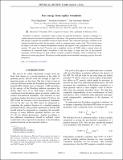Free energy from replica wormholes
Author(s)
Engelhardt, Netta; Fischetti, Sebastian; Maloney, Alexander
DownloadPublished version (934.3Kb)
Publisher with Creative Commons License
Publisher with Creative Commons License
Creative Commons Attribution
Terms of use
Metadata
Show full item recordAbstract
© 2021 authors. Published by the American Physical Society. Euclidean wormholes - geometries which connect disconnected boundaries - present a challenge to a standard quantum mechanical interpretation of the theory. One potential resolution is that the gravitational path integral computes the ensemble average of many theories. The connected topologies contribute to the simplest possible observable: the free energy, which is computed using a replica trick. This is distinct from the replica trick used to compute entanglement entropies and appears in the computation of any extensive quantity. We argue that both JT gravity and a simplified version of CGHS admit a regime where the contribution of connected replica wormholes to the free energy is larger than that of disconnected topologies. In both theories we find evidence of replica symmetry breaking, which is reminiscent of the behavior of certain spin glasses. We discuss possible insights about ensemble averaging in gravity from this perspective.
Date issued
2021Department
Massachusetts Institute of Technology. Center for Theoretical Physics; Massachusetts Institute of Technology. Department of PhysicsJournal
Physical Review D
Publisher
American Physical Society (APS)
Citation
Engelhardt, Netta, Fischetti, Sebastian and Maloney, Alexander. 2021. "Free energy from replica wormholes." Physical Review D, 103 (4).
Version: Final published version